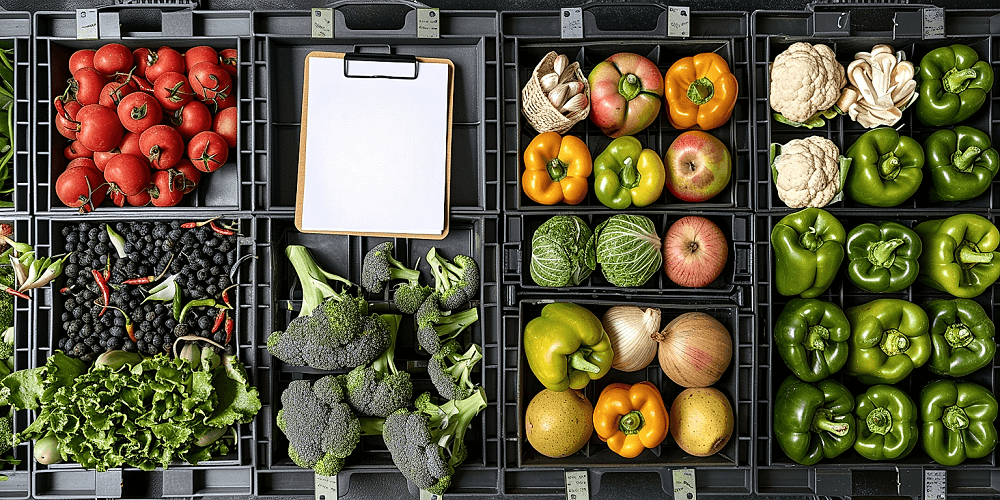As every produce distributor acknowledges, audits can be a daunting task.
This is particularly true if your organization lacks the effective strategies necessary for a successful audit preparation.
While audits can seem overwhelming, they present an opportunity to reinforce best practices and ensure regulatory compliance.
In the rapidly evolving world of food safety regulations and distribution processes, audits are more important than ever.
Therefore, it’s imperative for companies to properly prepare for these assessments.
Investing in an effective audit preparation strategy is not just important, it’s a business necessity.
Contents
- Audit Prep Strategies For Produce Distribution
- 1. Organize all invoices, receipts, and delivery logs.
- 2. Verify Current Licenses, Permits and Certifications.
- 3. Regularly Clean and Sanitize Storage Facilities
- 4. Document all product quality control checks
- 5. Establish Clear Traceability Procedures
- 6. Review and Reconcile Inventory Regularly
- 7. Maintain and Update Employee Training Records
- 8. Test Recall Procedures Regularly
- 9. Regularly Inspect Farming and Storage Equipment.
- 10. Ensure regulations compliance for packaging and labeling.
- The Bottom Line
Audit Prep Strategies For Produce Distribution
1. Organize all invoices, receipts, and delivery logs.
One core component of a successful audit prep strategy for produce distribution is in the organization of all invoices, receipts, and delivery logs.
It’s essential that these financial and logistical documents are kept organized and readily accessible so that auditors can quickly verify that transactions and deliveries align with business records.
By maintaining a systematic approach to organization, businesses ensure that all necessary information is easily accessible.
Regular monitoring and management of these documents can significantly decrease the time spent looking for them during audits.
Specific digital solutions like document management systems (DMS) can hugely improve productivity and efficiency.
These systems can automate the process of organizing receipts, invoices, and delivery logs, making audit preparation much less taxing.
Management of invoices and receipts is not only crucial for audit purposes but also for tracking financial performance, making accurate forecasts, and planning for growth.
Clear management of delivery logs can be instrumental in verifying that produce was picked, packed, and delivered in compliance with regulatory requirements.
Proper organization of records might also reveal inconsistencies or gaps in the distribution process, which could be detrimental to both compliance and overall business performance.
Auditors focus on accuracy and consistency in records, and these documents are integral to demonstrating a strong operational framework.
Staying organized in terms of invoices, receipts, and delivery logs can be a powerful tool against violations during an audit check.
Good organization also allows for a comprehensive overview of the business’s transactions, enabling companies to identify trends or anomalies that could indicate potential financial or logistical issues.
Such meticulous organization goes a long way in presenting a positive image to auditors, subsequently increasing the chances of a successful audit.
In conclusion, the organization of invoices, receipts, and delivery logs might seem like a basic task, but when done effectively, it carries a tremendous impact on audit outcomes.
The more effectively and systematically these records are managed, the more prepared a company will be for a smooth and successful audit.
It is, therefore, imperative for produce distribution companies to prioritize the organization of invoices, receipts, and delivery logs as part of their audit preparation strategy.
2. Verify Current Licenses, Permits and Certifications.
In the produce distribution industry, compliance is not optional but a mandatory requirement. It serves to assure clients, stakeholders, and regulatory bodies that the business operates within the stipulated guidelines and regulations.
As an integral part of an audit preparation strategy, verifying current licenses, permits, and certifications is a task that should be given high priority.
One of the first steps to take is to conduct an inventory of all operational licenses and permits that your business holds.
This would usually range from business operation licenses, environmental permits, health and safety certifications, and any other permits specific to your specific industry or location.
To make this task effective, have a system that not only tracks these licenses and permits but also their renewal dates. Regular updates and checks will ensure that none lapses unnoticed.
Verifying permits and certifications isn’t just about ensuring that they are current, but also about assessing their relevance and adequacy.
This involves comparing your permits and licenses with the current regulations and industry standards, ensuring that they are all up-to-date and in compliance.
If discrepancies are observed, immediate steps should be taken to rectify the situation. In case of imminent audit, this quick action could be potentially save the business from heavy penalties or even a shutdown.
Furthermore, the verification process should also be extended to include licenses and permits of suppliers and subcontractors who are part of your supply chain.
Ensure that all suppliers and subcontractors have up-to-date paperwork and certifications needed to operate legally and safely in their domains.
This extensively helps in maintaining the overall compliance and integrity of your business, and guarantees seamless audit processes pertaining to supply chain management.
It’s important to remember that the audit process is aimed at ensuring that businesses operate at the highest level of professionalism, service delivery, and integrity.
Therefore, having all your licenses, permits, and certifications in order is not just beneficial during an audit, but constitutes a fundamental pillar in executing best industry practices.
In a nutshell, verification of licenses, permits and certifications as part of the audit preparation strategies, strengthens the company’s reputation, maintains the trust of clients and stakeholders, and ensures smooth regulatory inspections.
More importantly, this action reinforces the company’s commitment to quality service delivery and regulatory compliance.
3. Regularly Clean and Sanitize Storage Facilities
Cleanliness and sanitation practices are central to maintaining product quality and ensuring food safety within any produce distribution facility.
Regular cleaning not only keeps your storage facilities physically appealing but also helps prevent the build-up of bacteria and other potential sources of contamination.
To accomplish this, you might need to schedule regular deep-cleaning sessions besides the routine day-to-day cleaning activities.
It is essential to adopt standardized cleaning procedures, this helps in maintaining the efficiency and effectiveness of the cleaning process.
Consider using approved cleaning agents and disinfectants that are safe for use around food products.
The cleanliness and sanitation level in the facilities play a major role in determining the shelf-life and overall quality of the fruits and vegetables.
Additionally, it ensures that your facility meets auditing standards by maintaining a healthy and safe environment for both the workers and the produce.
It would be prudent to train employees on sanitation procedures, as they would be directly involved in maintaining the cleanliness of the storage facilities.
The training should include the correct use of cleaning tools and instructions on handling the cleaning chemicals.
It is advisable to document all sanitation activities; this serves as proof during audits that your facility met cleanliness and sanitation regulatory standards.
Regular inspections should also be conducted to ensure that all cleaning and sanitation guidelines are being followed meticulously.
Investing in modern and effective cleaning equipment could significantly increase the efficiency of your sanitation procedures.
Besides cleaning, pest control measures must also be a critical part of your sanitation protocol. Pests can pose a severe threat to stored produce, resulting in massive losses.
Lastly, always remember that transparency is vital in any auditing process, hence, do not attempt to cover up or ignore any potential sanitation issues but instead seek proactive remedies.
Remember, the cleaner and healthier your storage facilities, the higher the likelihood of passing an audit and safeguarding the quality of your produce.
Therefore, a well-maintained storage facility is a clear demonstration of your commitment to best practices and health and safety.
4. Document all product quality control checks
One of the most crucial parts of preparing for an audit in a produce distribution company is documenting all product quality control checks.
This involves monitoring and keeping track of all quality related activities that the company performs on the produce from the point it enters the facility until it leaves.
This is a comprehensive process and includes activities such as inspection of incoming produce, checking temperature controls, verifying sanitation procedures and recording results of laboratory tests.
The documentation approach varies based on the size of the company and the complexity of the produce being handled, but the goal is to have a paper trail that is comprehensive, transparent and easily auditable.
There are significant benefits to this approach such as reduction in errors, improved produce quality, and evidence for regulatory and certification bodies.
Another crucial element is ensuring that the documentation is easily accessible and organized in a manner that facilitates quick retrieval and review by the audit team.
This means that documents should also be properly titled, dated and signed by whoever carried out the quality control test.
Furthermore, these records should be reviewed periodically by management as part of a cross-checking procedure to ensure that they are accurate and complete.
Digital record keeping with a software that enables real-time visibility and report generation can dramatically simplify this process and improve accuracy.
Quality control checks may vary depending on the nature of the produce, but the fundamental aspect remains the same: assuring that the product is safe, healthy and meets the quality standards set by the company and the regulatory bodies.
These records work as evidence for the auditor that your company is not just performing these checks but is also taking appropriate action based on the results.
So even in cases where quality issue is identified, the way the company responded to it and the corrective actions taken can reflect positively during an audit.
Documenting all product quality control checks is not just a standard industry practice but also a strategic step towards building a robust and compliant food safety culture within the company.
While the process may seem daunting at first, it becomes manageable once it’s part of a regular routine and is systematically performed by trained and accountable employees.
It serves a dual purpose: not only does it help in preparing for an audit but it also improves the overall operational efficiency and product quality.
5. Establish Clear Traceability Procedures
Traceability procedures are a critical aspect of produce distribution that cannot be overlooked during audit preparations.
In the produce distribution sector, this refers to the ability to chronologically track and trace every step taken by a product throughout all stages of production, processing, and distribution.
This not only enhances product safety, it also strengthens accountability in case of product recalls or other unforeseen circumstances.
Establishing clear traceability procedures involves having a well-documented procedure that outlines every movement of the product from the field to the consumer’s plate.
In the world of produce distribution, transparency and accountability are key, and establishing clear traceability procedures is the first step towards achieving this.
One of the essential elements of establishing transparent traceability procedures is product coding.
Produce should be properly identified through a coding system that provides real-time information about the farm of origin, harvest date, and delivery procedures.
Fulfilled, this creates a clear link between the consumer and the produce.
Another significant element is having a comprehensive record-keeping system that not only records the product’s movements but also the inspections and quality control checks it goes through.
This helps in quick decision-making during product recalls and improves overall customer satisfaction.
Furthermore, to test the effectiveness of the traceability procedures, traceability audits can be carried out regularly.
This involves tracing a batch of produce back to their respective farms to check if all recorded data matches the actual movements of the product.
If discrepancies are found during the traceability audit, the procedure steps associated with the discrepancies are analyzed and suitable corrective actions are taken.
Traceability procedures are not only for compliance with audit requirements, but they are also fundamental to creating trust and confidence with consumers.
It also tends to increase market competitiveness for businesses in the produce distribution industry.
Indeed, establishing clear traceability procedures is an ongoing process that requires continuous efforts in order to ensure its success regularly.
6. Review and Reconcile Inventory Regularly
The regular review and reconciliation of inventory are integral components of audit preparation in the produce distribution industry.
In the bid to ensure operational efficiency and financial accuracy, it is vital to conduct frequent inventory checks.
Through regular review and reconciliation, distributors can easily identify any variances between recorded inventory and actual inventory.
Regular inventory review and reconciliation is a proactive approach to minimizing the risk of stock loss due to theft, spoilage, and accounting errors.
When inventory discrepancies arise, prompt investigations should be conducted to ascertain the causes.
Where necessary, adjustments need to be made to rectify the accounting of the actual inventory on hand.
Regular reconciliation of the inventory allows for the detection of anomalies early enough to prevent significant financial loss.
Inventory reconciliation also aids in the accurate pricing of inventory, which is a critical factor in the balance sheet statement.
More so, inventory review best practices involve verifying the quality and condition of stored items, a crucial step that ensures the goods are in the perfect state for distribution.
Automated inventory management systems can significantly simplify and improve the accuracy of inventory reviews and reconciliation, thereby reducing the chances of human error.
These systems can prompt regular physical counts, automate the reconciliation process, and highlight discrepancies for investigation.
Inventory auditing will also ensure that the produce distributor maintains compliance with industry regulations.
Comprehensive and accurate inventory management is a core requirement for certifiers, auditors, and industry regulators.
By conducting regular inventory reviews and reconciliation, the produce distributor builds a record of compliance useful during an audit.
Finally, regular inventory review and reconciliation create a greater level of accountability amongst employees as stock is closely monitored.
This measure not only helps to prevent stock loss but also promotes excellence and integrity in the workforce.
7. Maintain and Update Employee Training Records
Employee training is a crucial part of any produce distribution operation, directly implying the need to maintain and update these records regularly.
The accuracy and up-to-dateness of these records rids an organization of avoidable operational disruptions during audits.
Consequently, it’s important that businesses establish a system for updating employee training records as soon as any training is completed.
This system should also provide timely and accurate data to management, to help them make the right decisions, particularly in times of audits.
On a related note, having a centralized and digital database for these records eases the access and retrieval process, especially during audits.
A centralized system also eliminates the risk of losing physical copies of the records or having them damaged, making it a more reliable and efficient solution.
The system should also be scalable to accommodate growth in staff, training programs, and to meet regulatory changes.
Such a system ought to have a feature to set reminders or alerts for when it’s time to conduct refresher training sessions or when certifications are set to expire.
Keep in mind, one of the reasons for maintaining updated training records is to ensure employees are well-versed in all necessary audit protocols.
Remember that some audit standards require businesses to prove that their employees are appropriately trained, so the ability to quickly produce accurate, up-to-date training records is invaluable.
The process of maintaining and updating employee training records should include a clear procedure for storing these records, which includes confidentiality measures to protect employee data.
Additionally, staff should be trained on the importance of these records, how to record them and the implications of errors in recording.
Audit preparation is much easier when employee training is managed effectively, thus it should be a key focus area for all businesses in the produce distribution industry.
Overall, it’s clear that keeping an updated record of your team’s training and certification will assure potential auditors of your seriousness towards compliance regulations.
An organization that frequently updates its employees’ training records not only prepares itself for audits but also contributes towards continuous team development and improvement of service delivery in the produce distribution industry.
8. Test Recall Procedures Regularly
Within the produce distribution sector, recall procedures play an essential role in safeguarding the public from unsafe products.
Conducting regular tests of these procedures is an essential part of an audit preparation strategy.
These tests not only help to identify potential areas for improvement but also serve as an opportunity to train staff on recall responsibilities.
Given the potential for recalls to significantly impact a business, both in terms of financial costs and reputation, testing these procedures is especially critical.
Having effective and well-tested recall procedures in place is crucial in mitigating the risks associated with foodborne illnesses or other safety concerns that might lead to a product recall.
To successfully test recall procedures, distribution facilities should first ensure they have a clear and detailed recall plan in place.
This plan should include information such as recall decision-making processes, notification procedures, recall response strategies, and post-recall actions.
A simulated recall can then be conducted regularly to test the effectiveness of this plan.
This could involve identifying a particular batch of product as if it were subject to a recall and tracking this product through the entire distribution chain.
The time taken to trace all products, the efficiency of communication channels, and the level of staff participation and understanding are all aspects that can be observed and assessed during such a test.
If any deficiencies in the recall plan are noted during these tests, actions can then be taken to improve these areas before an actual recall situation occurs.
Kickstarting the remediation process immediately after a test is crucial to avoid the repetition of the same mistakes during a real recall.
Information gathered from each test should be documented and utilized as a reference to continually fine-tune your recall procedures.
The combination of regular testing and continual improvement lends itself to an effective recall response strategy and ultimately, a more resilient produce distribution business.
Therefore, regular testing of recall procedures should be a key part of your audit preparation strategy for safer and more effective produce distribution.
9. Regularly Inspect Farming and Storage Equipment.
Regular inspection of farming and storage equipment is crucial in the produce distribution business.
To ensure the smooth operation of the business and to maintain the quality of the produce being distributed, every piece of equipment should undergo regular maintenance and inspections.
The frequency of the inspections can depend on the type and age of the equipment, but it should be at least once a year or as recommended by the manufacturer.
Some inspections need to be performed more frequently, especially for high-use equipment or those involved in critical operations.
Manual handling equipment like pallet trucks, forklifts, and conveyor belts must be examined thoroughly for any signs of failure or malfunction.
This involves any safety devices, controls, brakes, alarms, and other critical parts to ensure they are all working efficiently.
Farming equipment like tractors, harvesters, and plowing machines should also be inspected regularly.
Failing to maintain them can lead to reduced operational efficiency, increased risk of accidents, and potential loss of crops due to inadequate processing or storage.
Storage facilities require special maintenance and inspection, especially cooling and refrigeration systems to keep produce fresh and avoid spoilage.
They must be clean, well-maintained, and functioning efficiently to provide the right temperature and humidity levels for the produce.
It is worth considering using software that can assist with managing equipment inspection schedules, keeping records of maintenance activities and reminding personnel when inspections are due.
A regular visual inspection, including checking for leaks, unusual noises, and operational inefficiency, can catch many problems early before they develop into serious issues.
Having a trained professional to conduct more detailed inspections and carry out regular preventative maintenance is advisable.
The resulting reports from these inspections should then be carefully studied and used to inform future inspections, identifying trends or recurring issues.
An inspection logbook should be maintained and kept on the premises for quick reference in case of audits or inspections by regulatory authorities.
Remember, regular inspection and maintenance of farming and storage equipment is not only a safety measure but can prevent costly downtime and assist in producing high-quality produce.
10. Ensure regulations compliance for packaging and labeling.
Compliance with packaging and labeling regulations is a crucial aspect of a produce distribution business.
For goods to not only reach their final destination but to also meet the set standards, this is an area that you can’t afford to ignore.
There are local, regional, and even international standards that stipulate how products should be packaged and labeled.
Auditors will verify your compliance with these regulations to ascertain the quality of your distribution processes.
As a result, having thorough knowledge of these regulations and effectively applying them will help keep your business in good standing.
Furthermore, ensuring regulation compliance also aids in protecting your brand reputation, maintaining customer trust and avoiding potential legal issues.
Different produce might require different packaging and labeling standards, depending on their nature and destination.
For example, perishable goods might need specific packaging materials and conditions to ensure their freshness.
On the other hand, the labeling should be accurate and clear, indicating the product’s nature, origin, ingredients, expiration date (if applicable) and other relevant information as per the regulations.
This is because transparent and honest labeling and packaging are not only regulatory requirements but also ethical business practices.
It’s essential to train your employees on these packaging and labeling standards.
This will enable them to adhere to these standards at all times, therefore ensuring consistent compliance.
Audit preparations should therefore entail a thorough review of your packaging and labeling processes.
You should verify whether they align with the regulatory requirements and identify any gaps for immediate correction.
It’s prudent to always stay updated with any changes in these regulations to ensure continued compliance.
Moreover, maintaining a record of your packaging and labeling activities and being able to provide evidence of compliance can be a significant advantage during an audit.
You may even consider engaging a regulatory compliance expert or legal counsel who specializes in this area to ensure that you’re always in line with regulatory demands.
The Bottom Line
Maintaining a high standard of food safety management is a complex and ongoing task, involving thorough organization of financial documents and records, verification of legal credentials, maintaining cleanliness of storage facilities, and meticulous documentation of product checks.
Additionally, traceability procedures are crucial to swiftly handle potential safety issues.
Reconciliation of inventory can prevent wastage and help in maintaining freshness.
Employee training is integral to ensure that these procedures are carried out correctly.
Regular testing of recall procedures and inspection of equipment helps in tackling potential problems proactively.
Finally, an adherence to regulations for packaging and labelling ensures that products are safe for consumption and provide accurate information to customers.
All these tasks are crucial to ensuring that food safety management steps are followed rigorously and regularly, thereby safeguarding the well-being of customers.




